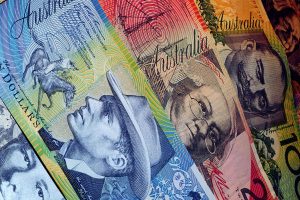 Yesterday’s trade saw AUD/USD within the range of 0.7039-0.7124. The pair closed at 0.7107, surging 0.54% on a daily basis. It has been the 8th gain in the past 20 trading days.
Yesterday’s trade saw AUD/USD within the range of 0.7039-0.7124. The pair closed at 0.7107, surging 0.54% on a daily basis. It has been the 8th gain in the past 20 trading days.
At 9:58 GMT AUD/USD was losing 0.87% on the day to trade at 0.7046. The pair touched a daily low at 0.7042 at 9:54 GMT, making a higher-low test of the low from February 1st, and a daily high at 0.7129 during mid-Asian trade.
On Tuesday AUD/USD trading may be influenced by the following macroeconomic report as listed below.
Fundamentals
Australia
AiG Performance of Services Index
At 22:30 GMT the Australian Industry Group (AIG) is expected to announce the results from its survey on short-term and intermediate-term conditions in the countrys services sector during January. Surveyed companies answer questions associated with production, employment, prices, supplier deliveries, inventories and new orders. The seasonally adjusted Performance of Services Index (PSI) for Australia came in at a reading of 46.3 in December, or the lowest level since November 2014. December has also been the third consecutive month, when the gauge inhabited the area below 50.0. Values below the key level of 50.0 are indicative of pessimism (lower activity). An improvement in the value of this indicator would provide a limited-to-moderate support to the Aussie dollar.
RBA kept the cash rate unchanged at record lows
At the policy meeting concluded on February 2nd the Reserve Bank of Australia left its benchmark cash rate intact at the record low level of 2%, in line with market expectations. The benchmark rate has been at that level since May 2015. RBA policymakers stressed that continued low annual inflation in the country may lead to easier policy, in case that is seen as an appropriate measure to boost demand.
According to extracts from the statement offered by RBA Governor, Glenn Stevens: “In Australia, the available information suggests that the expansion in the non-mining parts of the economy strengthened during 2015 even as the contraction in spending in mining investment continued. Surveys of business conditions moved to above average levels, employment growth picked up and the unemployment rate declined in the second half of the year, even though measured GDP growth was below average.”
“Inflation continues to be quite low, with the CPI rising by 1.7 percent over 2015. This was partly caused by declining prices for oil and some utilities, but underlying measures of inflation are also low at about 2 percent. With growth in labour costs continuing to be quite subdued as well, and inflation restrained elsewhere in the world, consumer price inflation is likely to remain low over the next year or two.”
“Given these conditions, it is appropriate for monetary policy to be accommodative. Low interest rates are supporting demand, while regulatory measures are working to emphasise prudent lending standards and so to contain risks in the housing market. Credit growth to households continues at a moderate pace, albeit with a changed composition between investors and owner-occupiers. The pace of growth in dwelling prices has moderated in Melbourne and Sydney over recent months and has remained mostly subdued in other cities. The exchange rate has continued its adjustment to the evolving economic outlook.”
Daily and Weekly Pivot Levels
By employing the Camarilla calculation method, the daily pivot levels for AUD/USD are presented as follows:
R1 – 0.7115
R2 – 0.7123
R3 (range resistance) – 0.7130
R4 (range breakout) – 0.7154
S1 – 0.7099
S2 – 0.7091
S3 (range support) – 0.7084
S4 (range breakout) – 0.7060
By using the traditional method of calculation, the weekly pivot levels for AUD/USD are presented as follows:
Central Pivot Point – 0.7048
R1 – 0.7180
R2 – 0.7275
R3 – 0.7407
S1 – 0.6953
S2 – 0.6821
S3 – 0.6726





